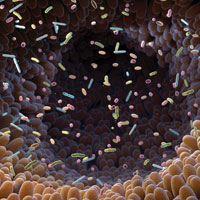Gut Microbiome May Be Involved in Social Anxiety Disorder
The gut microbiome may play a role in social anxiety disorder (SAD), according to a new
laboratory study published in
PNAS. The study showed that mice transplanted with gut bacteria derived from humans with SAD displayed heightened sensitivity to social fear, but no other anxiety-like behaviors.
Investigators at University College Cork in Ireland and colleagues first collected fecal samples from six adults with SAD and six control adults with no history of any psychiatric disorder. The samples were then transplanted into male mice (72 total, six per human sample) who had their own gut bacteria depleted with antibiotic treatment.
Starting 10 days after transplant, the mice were administered a range of tests that assessed depressive and anxious behaviors. Overall, the mice performed similarly across most tests except for social fear conditioning (in which mice receive a foot shock when meeting another mouse); in these tests, the mice with SAD samples took longer to extinguish their fear of interacting with other mice. However, the general sociability of mice with the disorder and control mice was not different.
“This fits well with recent research indicating that a substantial proportion of individuals with SAD report normal (or even high) levels of extraversion and novelty seeking/openness to new experiences, despite their anxiety about social situations,” the investigators wrote.
A subsequent analysis of the animals’ brain tissue found that, compared with control mice, mice transplanted with SAD samples had fewer neurons that produce the social hormone oxytocin in the bed nucleus of the stria terminalis (BNST), a region critical for processing potentially threatening stimuli. The researchers also found that SAD mice had lower expression of oxytocin and the related hormone vasopressin in other areas of the brain.
Reduced Pupil Dilation May Signal Anhedonia
A
study appearing in
Scientific Reports offers more evidence that the pupils of individuals with depression dilate less when anticipating a reward than individuals without depression. In addition, the degree of pupil dilation seems to correlate specifically with symptoms of anhedonia (loss of pleasure).
Investigators at the Max Planck Institute of Psychiatry in Munich, Germany, recruited 40 adults with depression and not taking medication and 30 adults without depression to partake in a reward anticipation task while undergoing pupil scan. The task involved pressing a button as quickly as possible following a flash on the screen; depending on the pattern of the flash, a quick response was rewarded with one euro.
The investigators found that the pupils of individuals without depression dilated immediately after pressing the button on a reward-generating flash, but not after a neutral flash. In individuals with depression, the pupil dilation was significantly smaller. These results replicated a
study from 2020.
Next, the investigators combined the data from both studies (81 adults with depression and 55 controls) to examine whether any specific depressive symptoms were linked with this decreased pupillary response; all participants filled out the Beck Depression Inventory-II upon enrollment, which rates severity of 21 symptoms.
They found that the degree of pupil dilation correlated most strongly with three anhedonia-related symptoms: loss of pleasure, loss of energy, and loss of sexual interest.
The investigators wrote that these findings provide further support that reward-related arousal is disrupted in many people with depression. The results also “highlight the potential of pupillometry to provide a noninvasive biologically driven measure … to assess anhedonia-related symptomatology.”
Common Elective Surgeries Not Linked To Dementia Risk
Common elective surgeries like hip replacements are not associated with an increased risk of dementia in older adults, according to a
study in the
Journal of the American Geriatrics Society.
“There is a large and controversial amount of literature evaluating the association with coronary revascularization and risk of incident dementia, but few studies have evaluated this association with noncardiac surgery,” wrote the researchers from the University of Calgary and colleagues.
The researchers used administrative databases in Ontario, Canada, to identify dementia-free adults aged 66 years and older who underwent one of five common elective surgeries between April 2007 and March 2011: hip replacement, knee replacement, hernia repair, prostatectomy, or hysterectomy. Each patient was then matched with another patient who had an outpatient visit regarding the same procedure but ultimately did not undergo surgery. The final sample included 13,939 matched pairs of adults.
To identify new dementia diagnoses, the patients were followed for up to five years. During that period, 640 (4.6%) individuals in the surgical group and 965 (6.9%) in the control group developed dementia. After adjusting for variables like health history and type of anesthesia used, the researchers found that individuals who underwent elective surgery had a 12% decreased risk of dementia compared with those who did not.
The researchers cautioned, however, that there are likely some unaccounted differences between the two groups, so the 12% finding may not signal a true protective effect for surgery.
Researchers Uncover Mechanisms Behind Neuron Insulation
Though neurons almost exclusively form chemical connections (or synapses) with other neurons, they can make synapses with another type of cell called an oligodendrocyte precursor cell (OPC). As
reported in
Nature Neuroscience, researchers have now found this neuron-OPC connection is critical for keeping neurons insulated and healthy.
OPCs are mobile precursor cells found throughout the brain. When activated, they mature into oligodendrocytes that wrap around neurons and coat them with myelin, a fatty compound that protects neurons and improves the efficiency of their electrical communication.
A team at Oregon Health & Science University and colleagues explored the mechanisms of OPC activation using zebrafish. These fish are translucent when young, enabling researchers to observe brain development and activity in live animals.
With the aid of fluorescent biomarkers and advanced microscopy, the researchers found that the pattern of myelin formation was partially dependent on where OPCs formed synapses with neurons before changing into mature oligodendrocytes. On average, each OPC formed around 10 ”hotspots” (areas where OFC synapses appeared and dissipated repeatedly over time) with its neuronal partner, and these locations subsequently received a large percentage of newly formed myelin.
When the researchers used tetanus toxin to block neurons from releasing neurotransmitters, OPC maturation was disrupted, leading to the production of fewer and shorter myelin sheaths.
The researchers noted a better understanding of myelin formation may have therapeutic implications, as disrupted myelination has been linked with a range of disorders such as multiple sclerosis, Alzheimer’s, and schizophrenia.
Co-locating OUD, Obstetrics Care Improves Patient Engagement
Co-locating substance use disorder treatment with obstetrics services can improve the care of pregnant women taking medication for opioid use disorder (MOUD),
reports a study in
Psychiatric Research and Clinical Practice.
Investigators at Michigan State University and colleagues compared health care engagement among expectant mothers in the Grand Rapids, Mich., area before and after the establishment of an integrated maternal fetal medicine-addiction clinic in July 2017. Before this time, pregnant patients on MOUD received care at a general addiction clinic and were referred to a nearby obstetrics and gynecology office within the same health system. They assessed 23 pregnant women taking buprenorphine who received prenatal care prior to the launch of the integrated clinic and 67 who received care after.
The investigators found that compared with patients receiving separate services, those who had co-located services had fewer missed obstetric visits (2.68 vs 6.10) and fewer missed OUD visits (2.28 vs. 4.33) during pregnancy on average. Over 85% of women receiving co-located services attended their 6-week postpartum clinic visit, compared with 52% of women who had separate services.
“In addition to greater attendance rates and engagement, we also found that mothers in the co-located treatment program had fewer MOUD visits overall compared to mothers in the isolated programs,” the investigators wrote. “Increased efficiency in fewer required appointments for care… helps increase accessibility and minimizes time and travel burdens to new mothers.”





